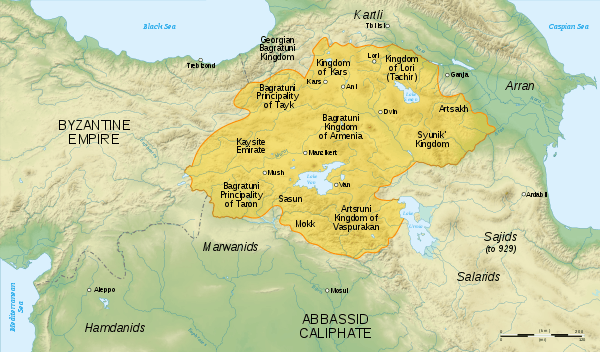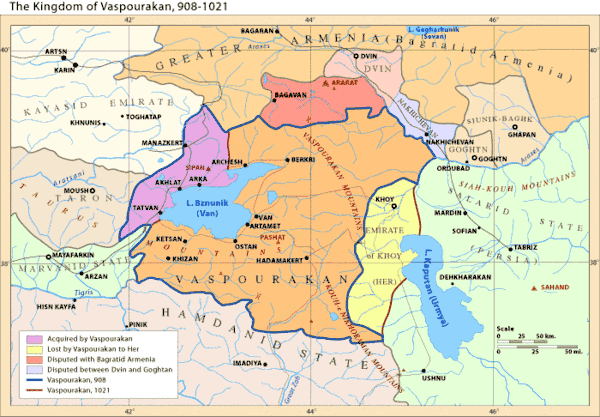Bagratuni dynasty
The Bagratuni or Bagratid (Armenian: Բագրատունի, Armenian pronunciation: [bagɾatuni]) royal family ruled many regional polities of the medieval Kingdom of Armenia, such as Shirak, Bagrevand[3], Kogovit (Armenian: Կոգովիտ)[4], Syunik, Lori, Vaspurakan, Vanand, Taron, and Tayk.[5] According to historian Cyril Toumanoff they are also accepted as the progenitors of the Georgian Bagrationi dynasty.[6][7]
| Bagratuni | |
|---|---|
 | |
| Parent house | Orontid Dynasty |
| Country | Armenia Caucasian Albania |
| Founded | 100 BC |
| Founder | Ashot I |
| Final ruler | Gagik II |
| Titles |
|
| Cadet branches | Rubenids (possibly) Hasan-Jalalyan (indirectly) |
Early history
The Bagratuni family became princes in the 4th century. Their heritable rights were given to them by the Arshakuni dynasty, the kings of Armenia (52-428). They were given the title aspet, the commander of the cavalry, and were given the privilege of crowning Arshakuni kings upon their accession to the throne. Their domain included the region of Sper in the Çoruh River valley of Upper Armenia, which was famous for its gold, and Tayk. Movses Khorenatsi claimed they had an ancestor, Sembat, who came to Armenia from Judea in 6th century BC, but this is considered by modern historians to be an invention to give a biblical origin to the family.[8]
The Bagratid family first emerged as nakharars, members of the hereditary nobility of Armenia. As early as 288–301, the Bagratid prince Smbat held the hereditary Armenian titles of Aspet, which means "Master of the Horse," and T'agatir, which means Coronant of the King.[9]
According to Prince Cyril Toumanoff, the earliest Bagratid prince was chronicled as early as 314 AD. In the 8th century, Smbat VII Bagratuni revolted unsuccessfully against the Abbasid Caliphate.



Bagratids in Armenia
The Bagratid Princes of Armenia are known as early as 1st century BC when they served under the Artaxiad Dynasty. Unlike most noble families of Armenia they held only strips of land, as opposed to the Mamikonians, who held a unified land territory. These are the earliest Bagratid princes in Armenia prior to the establishment of the kingdom, as mentioned by the Union of Armenian Noblemen. Ashot I was the first Bagratid King, the founder of the Royal Bagratid dynasty. He was recognized as prince of princes by the court at Baghdad in 861, which provoked war with local Arab emirs. Ashot won the war, and was recognized as King of the Armenians by Baghdad in 885. Recognition from Constantinople followed in 886. In an effort to unify the Armenian nation under one flag, the Bagratids subjugated other Armenian noble families through conquests and fragile marriage alliances. Eventually, some noble families such as the Artsrunis and the Siunis broke off from the central Bagratid authority.[10] Ashot III the Merciful transferred their capital to the city of Ani, now famous for its ruins. They kept power by playing off the competition between the Byzantine Empire and the Arabs.
They assumed the Persian title of "King of Kings" (Shahanshah).[11] However, with the start of the 10th century and on, the Bagratunis broke up into different branches, fragmenting the kingdom in a time when unity was needed in the face of Seljuk and Byzantine pressure. The rule of the Ani branch ended in 1045 with the conquest of Ani by the Byzantines.
The Kars branch held on until 1064. The dynasty of Cilician Armenia is believed to be a branch of the Bagratids, which later took the throne of an Armenian Kingdom in Cilicia. The founder, Ruben I, had an unknown relationship to the exiled king Gagik II. He was either a younger family member or kinsman. Ashot, son of Hovhannes (son of Gagik II), was later governor of Ani under the Shaddadid dynasty.
Gallery
 The Walls of Ani
The Walls of Ani Taraz (national costume) of an Armenian woman during Bagratid dynasty
Taraz (national costume) of an Armenian woman during Bagratid dynasty Bagratuni Kingdom of Armenia and Georgia, 884-962 A.D.
Bagratuni Kingdom of Armenia and Georgia, 884-962 A.D. Bagratuni Kingdom of Armenia, 1000 A.D.
Bagratuni Kingdom of Armenia, 1000 A.D. The vassal Kingdom of Vaspurakan, in Southern Armenia
The vassal Kingdom of Vaspurakan, in Southern Armenia
See also
- Bakran tribe
- List of Armenian kings
- Pakradouni (disambiguation)
References
- Bagratuni family Kings assumed the Persian title of "King of Kings" (Shahanshah).
- Tim Greenwood, Emergence of the Bagratuni Kingdoms, p. 52, in Armenian Kars and Ani, Richard Hovannisian, ed.
- Dictionary of toponymies of Armenia and adjacent regions, vol. 1, Yerevan, 1986, p. 536. In Armenian: Հայաստանի և հարակից շրջանների տեղանունների բառարան, հ.1, էջ 536: Bagrevand ... in the 9th-11th centuries was under the rule of the Bagratouni Kingdom of Armenia. Բագրևանդը … 9-11-րդ դարերում մտնում էր Բագրատունիների թագավորության տիրապետության մեջ:
- The Dictionary of the toponymes of Armenia and the adjacent regions, volume 3, Yerevan State University, YSU Publishing house, Yerevan, 1991, p. 182. "During the reign of the Arshakuni dynasty, the province of Kogovit belonged to the court, but after Arshakuni Kingdom's decline it passed to the Bagratuni princes".Հայաստանի եւ հարակից շրջանների տեղանունների բառարան, Թ.Խ. Հակոբյան, Ստ.Տ. Մելիք-Բախշյան, Հ.Խ. Բարսեղյան։ Երեւանի Համալսարանի Հրատարակչություն, Հատոր 3: Երեւան, 1991, էջ 182։ ՙՙԿոգովիտ գավառը Արշակունիների թագավորության ժամանակ պատկանում էր արքունիքին, իսկ նրա անկման շրջանում անցավ Բագրատունիներին՚՚:
- http://rbedrosian.com/Ref/CMH1.htm
- Toumanoff, C. Iberia on the Eve of Bagratid Rule, p. 22, cited in: Suny (1994), note 30, p. 349: "All this has now come to be accepted in modern Georgian historiography".
- Toumanoff, Cyril, "Armenia and Georgia", in The Cambridge Medieval History, Cambridge, 1966, vol. IV, p. 609. Accessible online at
- Kurkjian, Vahan (1958). A History of Armenia. New York: Armenian General Benevolent Fund. p. 186.
- Movses Khorenatsi. History of the Armenians. Translation and Commentary of the Literary Sources by R. W. Thomson. Cambridge, Massachusetts: Harvard University Press, 1978 Appendix A. Primary History, pp. 358-359, 362, 365-366
- Herzig, Kurkichayan, Edmund, Marina (2005). The Armenians: Past and Present in the Making of National Identity. Routledge. p. 43.
- Tim Greenwood, Emergence of the Bagratuni Kingdoms, p. 52, in Armenian Kars and Ani, Richard Hovannisian, ed.
- "Sebeos' History"
- John Mamikonean's History of Taron"
- "Aristakes Lastivertc'i's History "
- "Kirakos Gandzakets'i's History of the Armenians"
- Vahan Kurkjian - The Bagratid Dynasty — The Bagratuni
Genealogy
- Prince Cyrille Toumanoff, Manuel de généalogie et de chronologie pour l'histoire de la Caucasie Chrétienne (Arménie-Géorgie-Albanie). Edizioni Aquila, Roma, 1976. - still remains the only account of the family generally available in the West, although its scientific standard has been criticized as very low.
- The Families of the Nobility of the Russian Empire, Volume III, Moscow, 1996. - contains the latest research available in Russian, compiled by Georgian scientists, some of them Bagratids themselves.
- Armenian Nobility Site
- Robert Bedrosian's History Page
History
- R. H. Hewsen. "Armenia: A Historical Atlas", 2001 ISBN 0-226-33228-4
External links
![]()
